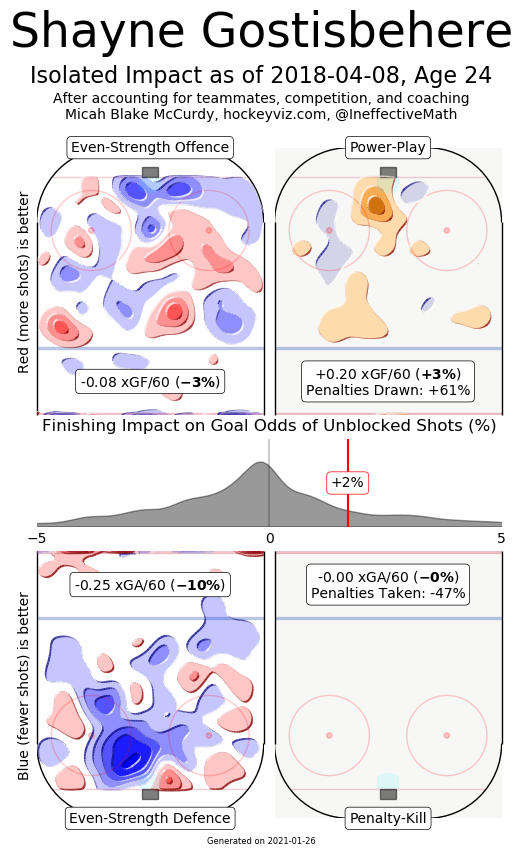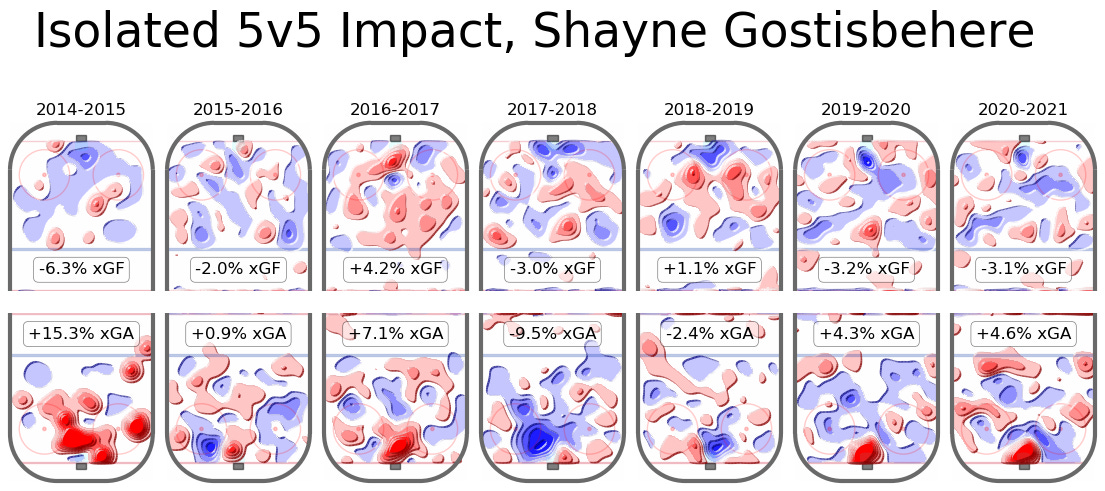Philadelphia Puts Gostisbehere on Waivers: should the Senators put in a claim?
In a somewhat surprising bit of news, the Philadelphia Flyers placed Shayne Gostisbehere on waivers yesterday at noon.
A third-round pick (78th overall) of the Flyers in 2014, Gostisbehere made a splash on his arrival into the league as a 22-year old during the 2015-16 season. In 64 games as a rookie, Gostisbehere scored 17 goals and 46 points earning himself First Team All-Rookie honours.
Since that prominent freshman year though, Gostibehere has struggled to replicate that success consistently. His most valuable season occurred during the 2017-18 campaign in which he scored 16 goals and 65 points in 78 games. That season blended his best offensive output with his one of his best defensive performances.
Evolving-Hockey.com pegged his 2017-18 season as being worth career-high 2.8 ‘Wins Above Replacement’ (WAR). HockeyViz.com’s work portrays that season as being Gostisbehere’s best.
There are a few things interesting about Gostisbehere, but what is intriguing here is how this season’s isolated defensive impact is significantly larger than any of his other ones. On another note, for a player who built a reputation for his offensive ability, his five-on-five isolated impacts haven’t really reflected across his career.
Gostisbehere’s rookie season set the bar for offensive production, but in looking at his numbers, it is easy to recognize that he benefited greatly from some good puck luck. A career 6.3-percent shooter, Gostisbehere scored on 11.2-percent of his shots during his rookie season. Regression was inevitable.
In his second season, Gostibehere’s offensive totals predictably dipped and that caught the attention of pundits. In 2016-17 however, it was hard to find a Flyer who did not experience some kind of setback. Claude Giroux arguably had his worst professional season scoring 14 goals and 58 points in 82 games. Michal Neuvirth and Steve Mason had a combined save percentage of .903. Together they combined to allow 15.66 goals more than would be expected per Evolving-Hockey’s data. It was just a terrible season for the team.
As I mentioned earlier, Gostisbehere’s best season was 2017-18, but under the hood, his defensive metrics looked to be improving with each season.
It was not just the percentage of total outcomes (shots, shots on goal, scoring chances, goals and expected goals), Gostisbehere’s rates improved as well. When he was on the ice, the rate in which the Flyers gave up shots, goals and expected goals decreased and it culminated with Gostisbehere’s best defensive season in 2017-18.
Since that time, Gostisbehere has struggled through knee injuries that he told Philadelphia reporters created an imbalance of strength in his legs.
"Just power (with) push-off," he said. "I was compensating so much over time. My quads were really uneven. It was hard to fix it off the ice, workout-wise. I had to get a procedure done and that helped a lot, getting my body back in line and feeling good again. It’s definitely been a tough road, especially with all this stuff going on. I am not going to feel bad for myself. There’s a lot of bad stuff going on in this world that people are worried about. I am just going to do my best to get back and be healthy."
The Philadelphia Flyers tried to trade Gostisbehere this past offseason, so it should not come as that much of a surprise to see them try and cut bait now.
Should the Ottawa Senators pick him up though?
With Thomas Chabot entrenched on the top pairing, the opportunity to add a player who has had success offensively and defensively while playing on a team’s top-four is enticing. Gostisbehere is 27-years old, so he is still young enough to be considered in his prime (or at least close to it).
The injuries that have affected his skating and strength are an obvious concern, but the price tag to acquire him is not inconsequential, but it’s not really that egregious either. The CapFriendly resource shows that Gostisbehere has two years left on his contract running through the 2021-22 season. Although his cap hit costs $4.5 million per season, Gostisbehere will earn $3.25 million in total salary in each of the last two years.
Under normal circumstances, the opportunity to add a player with a lower cap hit would fit the profile of what the Senators have done in recent years to inflate their cap hit. And unlike many other organizations who are pressed up against the salary cap ceiling, adding Gostisbehere’s contract should not negatively impact what the team can or cannot do over the next two seasons. At the same time however, if Gostisbehere does not pan out well, it could potentially add another deadweight contract to a contract to a situation that has players like Nikita Zaitsev and Matt Murray eating up valuable resources that can and should be used on better players. Ultimately, what may irk the organization however are the two $2.25 million signing bonuses that are due over the course of the next two years.
With Mike Reilly’s future uncertain as an impending unrestricted free agent, Christian Wolanin’s trade to the Los Angeles Kings and the possibility that Erik Brannstrom may need more development time in Belleville. It may make sense for the organization to look at putting in a claim in hopes that Gostisbehere finds his game with a change in scenery. At the very least, he could act as an insulation in the event that the Senators decide that contract negotiations with Reilly aren’t proceeding as well as hoped. If Jake Sanderson returns for his sophomore campaign to the University of North Dakota and the Senators are forced to trade Reilly, the team will need a decent defender to step in and play. Gostisbehere can be that guy and I think there are a few reasons to hope he can find his game, but given the signing bonuses and some of the risk involved, I just don’t see the Senators putting in a claim.
If Gostisbehere clears waivers however, that could lend itself to making a trade in which the Senators could shed some salary to accommodate the move. It could be something to keep an eye on.






